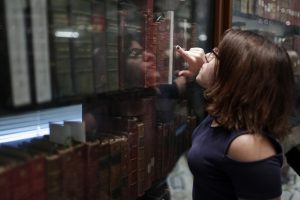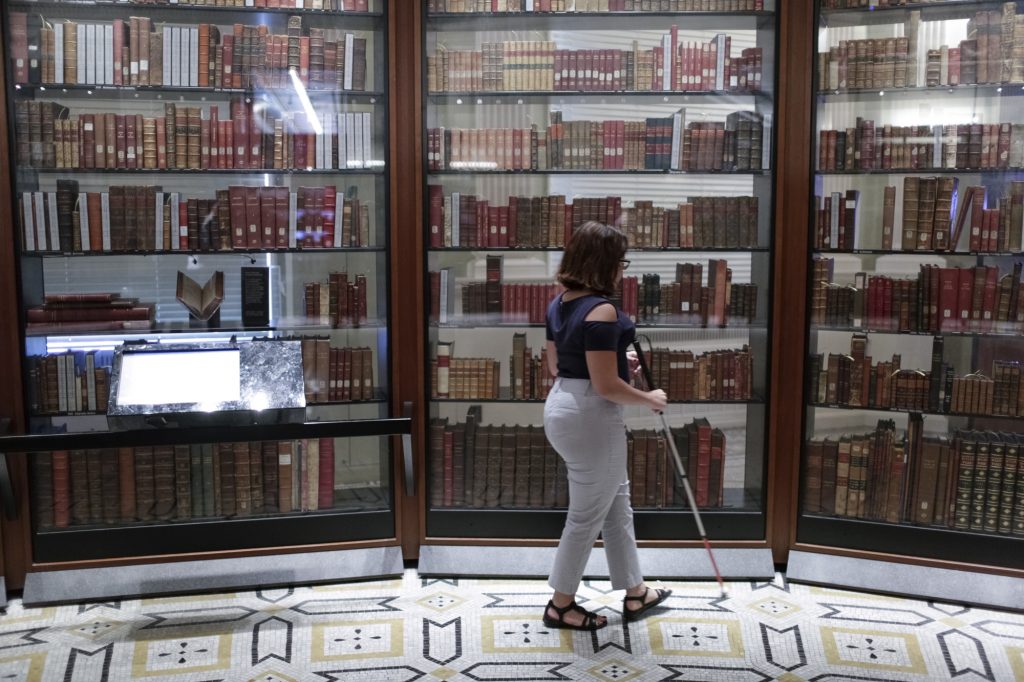This post is by Zein Al-Maha Oweis, a summer intern in the Library’s Communications Office.
Zein Al-Maha Oweis. Photo by Shawn Miller.
You know that feeling when Belle from “Beauty and the Beast” walks into the beast’s library of books from around the world—the gleam in her eyes that shows you she is amazed to see so many books creatively filled with words from different languages?
That is how I felt when the tour guide at the Library of Congress said, “Welcome to the Thomas Jefferson Library.” I walked around the exhibit hearing people chatting, cameras snapping and sounds of amazement. I moved closer toward the shelves. But before I could reach the books, I felt the glass case that preserves them.
You might wonder why all my descriptions are sounds. Well, the answer is simple: I am visually impaired with only touch and sound as my tools to navigate the world around me. Still, I love books, and I can never imagine myself living without them.
When British troops destroyed the Library of Congress in 1814, former president Thomas Jefferson saved the day by selling his personal library of 6,487 books to Congress. Although a second fire on Christmas Eve of 1851 destroyed nearly two-thirds of the volumes, the Jefferson books remain the core from which the present collections of the Library of Congress developed.

Photo by Shawn Miller.
The Thomas Jefferson Library exhibit is organized the same way Jefferson’s enlightened mind was organized. “He followed the premise of enlightenment, which is that all developments of the faculties of the human mind can be divided into three categories: memory, reason, and imagination,” explains Mark Dimunation, chief of the Rare Book and Special Collections Division. “He called them history, philosophy and fine arts.”
Physically, the space is also fashioned to reflect the way Jefferson used the library. “Jefferson wanted his books to be in a big circle, and he was supposed to sit in the center of it with his big desk and his Lazy Susan for books,” says Dimunation.
As you look around the moon-shaped cases with books hand-initialed by Jefferson, you can’t help but notice the white preservation boxes sitting among the sea of colorful spines. “These are the ghosts—these are the books that we are still looking for,” Dimunation says.
For 18 years now, the Library has been searching the world to replace the books lost in the 1851 fire. The goal is to match exactly the books that Jefferson owned. Later editions or editions published in other countries or cities won’t do. Dimunation has written to book specialists and sent emissaries to England, France and the Netherlands, and he and his team have even searched book dealers’ basements.
The way Jefferson collected titles makes the search especially challenging. Unlike other 18th-century bibliophiles, he collected his books in all languages. “His collection represents a much bigger base than almost any other collection in the world,” says Dimunation. Finishing the project requires locating 240 more books.
If you have not yet been to the Thomas Jefferson Library, I highly recommend a visit—you just might just see me sitting among the books, basking in all the wonders of the enlightened world. If you can’t make the trip, you can get your own—online—sense of the library here!

















